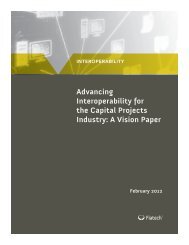An Introduction to ISO 15926 November 2011 - iRINGToday
An Introduction to ISO 15926 November 2011 - iRINGToday
An Introduction to ISO 15926 November 2011 - iRINGToday
You also want an ePaper? Increase the reach of your titles
YUMPU automatically turns print PDFs into web optimized ePapers that Google loves.
enefit is stability of information exchanges. Personnel can get on with whatever their business<br />
is without having <strong>to</strong> continually relearn old skills. Instead of having <strong>to</strong> spend all of their<br />
time fixing mapping problems, the IT group can do more value-added work.<br />
Done right, this can work well for quite a while. However, the longer an organization resists<br />
change the more work processes will become entrenched—tied ever stronger <strong>to</strong> old software<br />
and aging engineers. Change becomes unthinkable because of the knock-on effects that will<br />
ripple through the organization. Eventually support from the software vendors s<strong>to</strong>ps and the<br />
pool of trained users shrinks. The trick here is <strong>to</strong> know when <strong>to</strong> tightly adhere <strong>to</strong> this principle<br />
and when <strong>to</strong> let go.<br />
“You’ve got <strong>to</strong> know when <strong>to</strong> hold ’em, know when <strong>to</strong> fold<br />
’em…” 6<br />
A second approach <strong>to</strong> managing a large confederation of applications linked with cus<strong>to</strong>m<br />
point-<strong>to</strong>-point maps is <strong>to</strong> live with the maintenance and try <strong>to</strong> make it as organized and efficient<br />
as possible. Under this approach, as applications in the confederation evolve and the<br />
maps break someone will be there <strong>to</strong> fix the important ones.<br />
We might even argue that this is a good thing because it is a natural way <strong>to</strong> cull applications<br />
that are no longer useful. There may be some truth <strong>to</strong> that, but we must also acknowledge<br />
that the pace of innovation and change is speeding up. Business success, in some measure,<br />
goes <strong>to</strong> those organizations that make good decisions quickly. Good decisions require good<br />
information, and good information choked by inefficient information transfer is bad information.<br />
As with the first approach, we have developed good ways <strong>to</strong> handle maintenance. There is an<br />
entire business segment devoted entirely <strong>to</strong> what we call middleware <strong>to</strong> make creating and<br />
maintaining cus<strong>to</strong>m point-<strong>to</strong>-point maps easier and more reliable. Still, there will come a time<br />
when maintenance is a large cost.<br />
There is another solution, but it is a bit more work up front. Instead of making individual point<strong>to</strong>-point<br />
maps, an organization could make a dictionary of terms for all of the applications it<br />
uses. Under this approach, we study all of the software the organization uses and decide on<br />
the meaning of every term. Then when we link two applications we do not map them directly<br />
<strong>to</strong>gether but map each <strong>to</strong> the standard dictionary, as indicated in Figure 1.10.<br />
6. A line from The Gambler, a song by popular Country and Western singer Kenny Rogers.<br />
CHAPTER 1<br />
24



